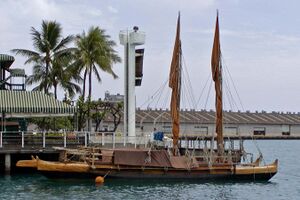Engineering:Hawaiʻiloa
Hawaiʻiloa (alt. Hawaiʻi Loa or Ke Kowa i Hawaiʻi) is a mythical Hawaiian fisherman and navigator who is said to have discovered the island of Hawaiʻi.
Legend
The legend contains reference to his children: Māui (his eldest son), Kauaʻi (son), and Oʻahu (daughter) who settled on the islands that bear their names.[citation needed]
Historical accuracy
However, there is currently little evidence to support its historical accuracy. The story is attested only by 19th-century sources such as Abraham Fornander and Thomas George Thrum, neither of whom provided their sources.[citation needed]
Canoe
Hawaiʻiloa is also the name of a voyaging canoe, built between 1991 and 1994.[1] Named after the legendary navigator, the canoe was built for ocean navigation and has sailed internationally. The canoe Hawaiʻiloa is now docked at Honolulu Harbor. It is often sailed on long voyages throughout the Pacific Ocean, studying voyaging techniques used in Ancient Hawaii.
Building
To make the canoe, two Sitka spruce logs were brought to Hawaiʻi from Southeast Alaska, donated by the SeAlaska Corporation (owned by the Tlingit, Haida, and Tshimshian tribes). These came from 400-year-old, 200 feet high trees, a size which could not be found in modern Hawaiʻi. The hulls of the canoe were designed by Rudy and Barry Choy and Dick Rhodes, and also used numerous woods from more local sources.[1] The canoe was made without metal parts, and used three miles of lashing.[2]
Hawaiʻiloa is 57 feet (17 m) long, with a beam of 19 feet (5.8 m). She has two sails, each of 240–420 square feet (22–39 m2). She was initially launched in July 1993, and subsequently modified in dry dock before being re-launched a year later.[1]
Voyages in 1995
In 1995, Hawaiʻiloa sailed her maiden voyage to Tahiti, Raʻiatea, and Nuku Hiva in the Marquesas Islands[3] in company with Hōkūleʻa and a third canoe from Hawaiʻi called Makaliʻi together with two canoes from Rarotonga: Te ʻAu Tonga and Takitumu, and the canoe Te ʻAurere, from New Zealand. Subsequently that year, Hawaiʻiloa was shipped to Seattle and then sailed north to Alaska, visiting twenty native villages on the coastal journey between Vancouver and Juneau.[2]
See also
- Hawaiki
- Hawaiian religion
- Hōkūleʻa
- Polynesian navigation
- Polynesian Voyaging Society
References
- ↑ 1.0 1.1 1.2 The Building of Hawai‘iloa archive.hokulea.com, accessed 2020-09-22
- ↑ 2.0 2.1 Nainoa Thompson: Recollections of the Building of Hawai‘iloa and the 1995 Voyages archive.hokulea.com, accessed 25 September 2020
- ↑ Nainoa Thompson - Biography www.ifa.hawaii.edu, accessed 25 September 2020
 |


